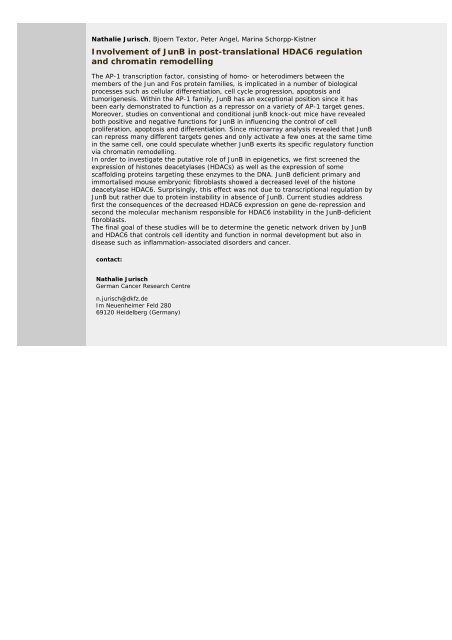Abstracts (poster) - Wissenschaft Online
Abstracts (poster) - Wissenschaft Online
Abstracts (poster) - Wissenschaft Online
You also want an ePaper? Increase the reach of your titles
YUMPU automatically turns print PDFs into web optimized ePapers that Google loves.
Nathalie Jurisch, Bjoern Textor, Peter Angel, Marina Schorpp-Kistner<br />
Involvement of JunB in post-translational HDAC6 regulation<br />
and chromatin remodelling<br />
The AP-1 transcription factor, consisting of homo- or heterodimers between the<br />
members of the Jun and Fos protein families, is implicated in a number of biological<br />
processes such as cellular differentiation, cell cycle progression, apoptosis and<br />
tumorigenesis. Within the AP-1 family, JunB has an exceptional position since it has<br />
been early demonstrated to function as a repressor on a variety of AP-1 target genes.<br />
Moreover, studies on conventional and conditional junB knock-out mice have revealed<br />
both positive and negative functions for JunB in influencing the control of cell<br />
proliferation, apoptosis and differentiation. Since microarray analysis revealed that JunB<br />
can repress many different targets genes and only activate a few ones at the same time<br />
in the same cell, one could speculate whether JunB exerts its specific regulatory function<br />
via chromatin remodelling.<br />
In order to investigate the putative role of JunB in epigenetics, we first screened the<br />
expression of histones deacetylases (HDACs) as well as the expression of some<br />
scaffolding proteins targeting these enzymes to the DNA. JunB deficient primary and<br />
immortalised mouse embryonic fibroblasts showed a decreased level of the histone<br />
deacetylase HDAC6. Surprisingly, this effect was not due to transcriptional regulation by<br />
JunB but rather due to protein instability in absence of JunB. Current studies address<br />
first the consequences of the decreased HDAC6 expression on gene de-repression and<br />
second the molecular mechanism responsible for HDAC6 instability in the JunB-deficient<br />
fibroblasts.<br />
The final goal of these studies will be to determine the genetic network driven by JunB<br />
and HDAC6 that controls cell identity and function in normal development but also in<br />
disease such as inflammation-associated disorders and cancer.<br />
contact:<br />
Nathalie Jurisch<br />
German Cancer Research Centre<br />
n.jurisch@dkfz.de<br />
Im Neuenheimer Feld 280<br />
69120 Heidelberg (Germany)

















